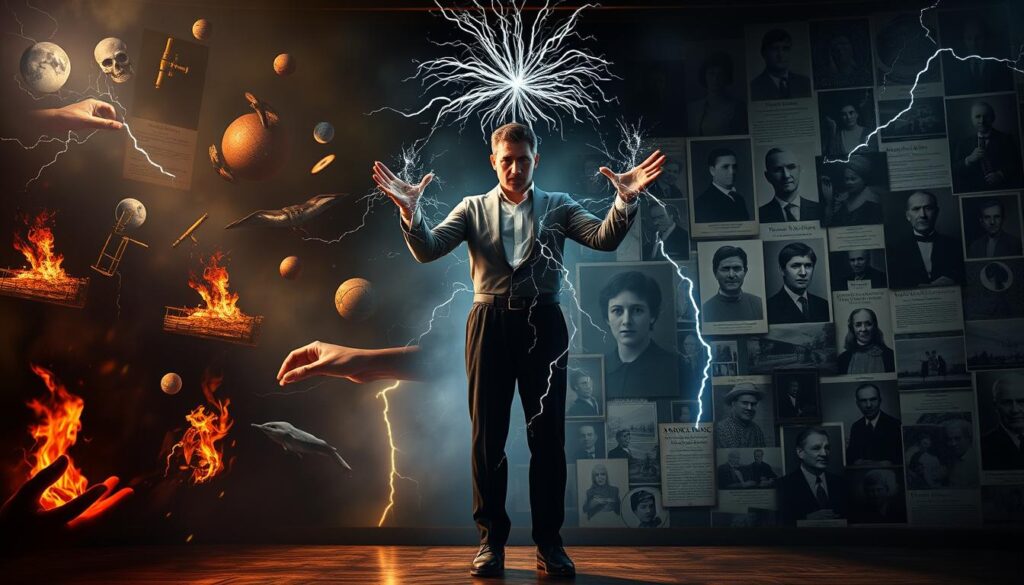Have you ever wondered if the mind could move objects without physical touch? This concept, known as psychokinesis, has fascinated people for decades. Stemming from the Greek words “psyche” (mind) and “kinesis” (movement), it suggests the possibility of influencing the physical world through mental focus alone.
While mainstream science remains skeptical—like the 1988 National Research Council report dismissing evidence—interest in this power persists. From Uri Geller’s spoon-bending claims to modern-day enthusiasts, the allure of unlocking hidden abilities captivates many.
This guide explores psychokinesis with an open mind, covering definitions, historical cases, and practical techniques. Whether you’re curious about parapsychology or seeking to test your own potential, we’ll walk you through it step by step.
Key Takeaways
- Psychokinesis involves influencing objects with the mind alone.
- The term comes from Greek words meaning “mind” and “movement.”
- Scientific studies, like the 1988 NRC report, remain unconvinced.
- Famous cases, such as Uri Geller, sparked widespread interest.
- This guide encourages curiosity while emphasizing critical thinking.
What Are Psychokinetic Abilities?
Can the human mind truly influence physical matter without touch? This question lies at the heart of telekinesis and psychokinesis, two terms often used interchangeably but with subtle differences.

Defining Psychokinesis and Telekinesis
Psychokinesis (PK) comes from the Greek psyche (mind) and kinesis (movement). It broadly refers to mental influence over physical systems. Telekinesis, from tēle (far) and kínēsis, specifically means moving objects remotely.
Modern parapsychology studies distinguish them: PK covers any mind-matter interaction (e.g., bending metal), while TK implies visible object movement.
Historical Roots in Parapsychology
The terms emerged separately:
- Telekinesis debuted in 1890 during spiritualist séances.
- Psychokinesis entered Merriam-Webster in 1914, popularized by researchers like William Barrett.
J.B. Rhine’s 1930s Duke University experiments tested PK by influencing dice rolls. Though controversial, they fueled scientific curiosity about the mind’s potential.
Understanding Psychokinetic Phenomena
From bending spoons to swaying dice rolls, psychokinetic effects range from dramatic to barely detectable. Researchers categorize these phenomena into two types: macro-PK, which involves visible changes, and micro-PK, where effects are subtle and statistical.

Macro-Psychokinesis: Visible Mind Over Matter
Macro-PK claims often feature striking examples like Uri Geller’s spoon bending or Eusapia Palladino’s séance table levitations. These objects appear to defy physics, but skepticism remains. A 2016 survey found only 35% of parapsychologists accept such claims due to replication issues.
Micro-Psychokinesis: Subtle Statistical Effects
Micro-PK focuses on tiny influences, like altering random number generators (RNGs). The PEAR Lab’s 1979–2007 experiments suggested minds might bias RNG outputs slightly. A 2006 meta-analysis of 380 studies found a small effect size (d=0.2), hinting at possible but elusive mental influence.
Today, micro-PK dominates research because it’s easier to test under controlled conditions. While macro-PK captivates imaginations, micro-PK offers a quieter, numbers-driven approach to studying psychokinesis.
Scientific Perspectives on Psychokinesis
Science has long debated whether the mind can truly alter physical reality. While psychokinesis captivates imaginations, it clashes with established laws of nature. Let’s examine the evidence—and why skepticism prevails.

Physics and the Limits of Mind Over Matter
Physics presents the biggest hurdle. Psychokinesis would violate the conservation of energy, inverse-square law, and thermodynamics. As physicist Robert Carroll notes, it would require a sixth fundamental force—unsupported by current science.
Consider casinos: if psychokinesis worked, players could bias dice or roulette wheels. Yet decades of data show no anomalies. Probability stays intact, undermining claims of mental influence.
Voices from the Skeptical Community
The skeptical community highlights flawed methods in PK research. James Randi’s 1981 Project Alpha exposed vulnerabilities. Magicians posing as psychics fooled researchers with simple tricks, revealing how easily bias creeps in.
Critics like Felix Planer argue that if PK were real, basic experiments—like moving a scale—would prove it. But no such demonstrations hold up under scrutiny.
When Experiments Fail
History is littered with failed experiments. The PEAR Lab’s RNG studies, once promising, crumbled after 250+ replication attempts. The National Academy of Sciences’ 1987 report dismissed PK’s military potential, citing zero credible evidence.
| Experiment | Outcome | Implication |
|---|---|---|
| PEAR Lab RNG (1979–2007) | 250+ failed replications | No statistical proof of PK |
| JREF $1M Challenge (1964–2015) | Never claimed | Lack of verifiable evidence |
| National Academy Review (1987) | 130-year analysis | No support for PK claims |
Even parapsychology studies concede the challenges. Without reproducible results, psychokinesis remains in the realm of mystery—not mainstream science.
Famous Claims and Cases of Psychokinesis
Throughout history, claims of mind-over-matter powers have sparked fascination and skepticism alike. From séances to TV spectacles, alleged telekinesis often crumbles under scrutiny—yet these stories endure as cultural touchstones.

Eusapia Palladino and the Séance Scandals
Italian medium Eusapia Palladino became infamous for her 1890s séances. Attendees swore she levitated objects like tables and chairs. But investigations revealed tricks—like using hidden limbs to mimic telekinesis.
In 1892, Milan researchers caught her lifting a table with her foot. Later, Cambridge scientists documented similar fraud. Despite exposure, Palladino’s shows drew crowds, highlighting how belief can overshadow evidence.
Uri Geller and the Spoon-Bending Controversy
In the 1970s, Uri Geller convinced millions he could bend metal with his mind. His TV specials featured objects like spoons twisting dramatically. Yet under controlled conditions—like a 1973 BBC test—his telekinesis failed.
A 2014 study found believers often misremember magic tricks as genuine phenomena. Geller’s career mirrors this: flashy performances thrived, while science dismissed his claims.
Why do these cases persist? Psychologist Richard Wiseman’s 1995 experiment showed confirmation bias—people recall hits, ignore misses. Today, social media amplifies similar telekinesis claims, proving old patterns die hard.
Can You Develop Psychokinetic Powers?
What if your thoughts could shape reality beyond imagination? While science remains skeptical, many explore ways to harness alleged abilities through mental training. Whether it’s bending spoons or influencing random events, the journey starts with the mind.

Meditation and Mental Focus Techniques
Tibetan tummo meditation, known for generating body heat, shares parallels with PK training. Practitioners visualize energy flow to alter physical states. A 1985 University of Edinburgh study found such techniques often misattribute minor movements (ideomotor effect) as power.
Common methods include:
- Visualization: Picturing objects moving while in deep focus.
- Energy manipulation: Imagining a “force” connecting mind and matter.
Harvard psychologist Daniel Wegner’s experiments show how easily humans perceive illusory causation—mistaking coincidence for control.
The Role of Belief and Placebo
Belief fuels perceived success. A 2002 meta-analysis revealed believers report three times more PK experiences, often due to confirmation bias. Ben Harris’ verbal suggestion experiments further proved how expectations create false perceptions of influence.
The placebo effect mirrors this: if you expect results, your brain might “see” them. Journaling objective outcomes—not just successes—helps counter self-deception.
As Scott Adams notes in God’s Debris, “Every thought ripples through the universe.” Whether that ripple moves mountains—or just minds—remains the question.
Conclusion
The debate over psychokinetic abilities continues to divide scientists and enthusiasts alike. Despite decades of research—from CIA experiments to university studies—no conclusive evidence supports the mind’s ability to move objects. Yet, cultural fascination persists, fueled by TV spectacles and anecdotal claims.
Instead of chasing unproven abilities, consider focusing on verified powers of the mind, like meditation or biofeedback. These techniques enhance focus and resilience without defying physics.
Stay curious, but demand proof. As technology advances, who knows what future discoveries might reveal? For now, critical thinking remains your best tool.

